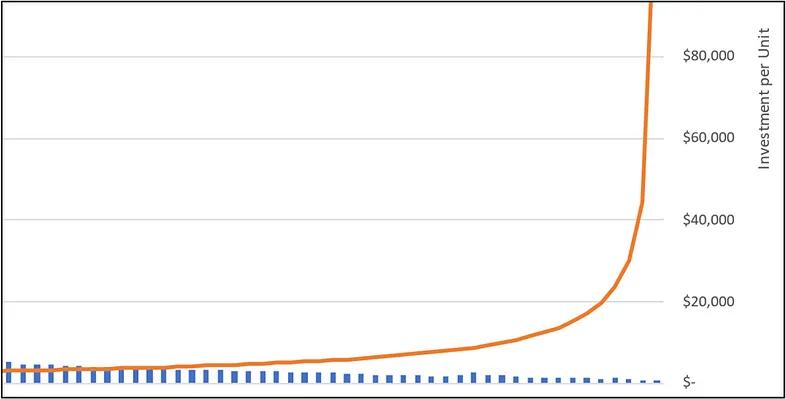Setting the Extremely High Cost Per Location Threshold for BEAD
Thursday, December 21, 2023
Digital Beat
Setting the Extremely High Cost Per Location Threshold for BEAD

It’s hard to know now exactly where the Extremely High Cost Threshold will land
Over the last 18 months, there’s been a lot of discussion about whether National Telecommunications and Information Administration (NTIA) struck the right balance in urging states to extend fiber as far as possible when implementing the $40+ billion Broadband Equity Access and Deployment (BEAD) Program. With all due respect to those who are passionate about their respective point of view—it’s time to step back and take a deep breath.
- It’s highly unlikely that many states will be able to use their BEAD allocation to get fiber 100 percent everywhere. There are a lot of reasons for that, but can we at least agree with that basic point, and move on?
- Congress and NTIA have given the states the responsibility for deciding where to draw the line—which areas are just “too costly” for fiber. The relative mix will vary from state to state, due to a variety of factors, including geography, who’s already in the state, and other rules that each state adopts for BEAD, such as how it defines proposed project areas.
- There will be locations served with other technologies. Fixed wireless and satellite are not excluded from BEAD. There’s a market for other technologies.
A critical tool that will determine the relative mix of fiber and other technologies is where states choose to set their Extreme High Cost Per Location Threshold (EHCPLT or Extremely High Cost Threshold).

It’s looking like most state broadband offices will set that threshold after they receive initial bids in their competitive grant process, not before, to avoid being boxed in. This creates more uncertainty for prospective BEAD applicants, particularly in states that are contemplating only a single grant round.
What is the Extremely High Cost Per Location Threshold, and why does it matter?
In its Notice of Funding Opportunity (NOFO) for BEAD, NTIA directed states to select fiber over non-fiber technologies—except where it costs too much. The “Extremely High Cost Per Location Threshold” is a BEAD subsidy cost per location that determines when states may select a less expensive technology over fiber. Essentially, the threshold determines where awardees will be able to use fixed wireless and potentially other technologies. Setting the threshold lower reduces the opportunity for fiber applicants to automatically win over non-fiber applicants, which allows finite BEAD dollars to go further.
Establishing the Extremely High Cost Per Location Threshold requires a tradeoff between more fiber—and running the risk there won’t be enough money in a particular state to bring internet to all—and having less fiber with money left over for community anchor institutions and non-deployment activities. Every state needs to evaluate where it draws the line, keeping in mind that the Administration’s goal is to bring high-speed, reliable internet to all. As explained in a prior article, 95 percent coverage is not an A—it’s a failure.
In the BEAD NOFO, NTIA said states should set the Extremely High Cost Threshold as high as possible to help ensure that fiber projects are deployed wherever feasible, but it did not require state broadband offices to specify their specific EHCPLT when they file their Initial Proposals. Rather, it indicated that states could describe the process they planned to use to select the threshold in their Initial Proposal.
Some have expressed concern that applicants will be handicapped if they don’t know in advance what the EHCPLT will be. But, after some reflection, there’s logic to this approach.
By setting the Extremely High Cost Threshold after the initial solicitation, states give themselves the freedom to select applications proposing non-fiber technologies in the areas where fiber bids are highest to make the sum of the state’s projects fit their budget. State broadband offices don’t want to dissuade non-fiber applicants from applying, not knowing now whether there will be applicants proposing to deploy fiber for each and every location in the state and not knowing the specific BEAD outlay that fiber applicants will seek for each and every project. Declining to set the threshold in advance puts some pressure on fiber applicants to submit reasonable requests because they won’t know the precise tipping point where the state may select non-fiber applicants.
Efforts to model the optimal Extremely High-Cost Per Location Threshold
There are only a relatively small number of states—mostly on the East Coast—that are expected to be able to utilize fiber for all unserved and underserved locations. Consulting firms, such as Cartesian working with ACA Connects, have estimated that most states will have to set their EHCPLT at a point that allows some fixed-wireless projects to be selected in order to cover all locations with their allotted dollars. The Vernonburg Group, sponsored by WISPA, has developed a Broadband Funding Optimization Tool to help state broadband offices see the impact of different tradeoffs.
Setting the Extremely High Cost Threshold after the bids have been submitted turns the bid selection process for state broadband offices into a complicated, but solvable, math puzzle. However, for prospective applicants, it introduces greater uncertainty going into the application process.
So, what are the implications for prospective BEAD applicants?
#1 — In many states, it’s going to be risky for a fiber provider to be the highest cost per location bidder in the state, particularly for projects of any significant size. Those areas are going to be the ones where the state broadband office will be motivated to find a non-fiber provider to serve at a lower cost to make the overall budget work. The state may set the threshold after receiving applications and then solicit additional applications.
#2 — Fixed-wireless providers may have the greatest success by focusing their attention on the specific areas within each state that are likely to be the most challenging to serve with fiber because those are the areas where the state can save the most money by picking fixed wireless over a fiber applicant. Fixed-wireless providers won’t win if they choose to pursue denser markets where fiber bids are likely to be under the Extremely High Cost Threshold.
#3 — Don’t assume that you’re the only one that’s going to apply for your targeted area. We learned from the FCC’s Rural Digital Opportunity Fund auction that competition for some rural areas will be vigorous. For anyone planning to pursue BEAD funding, doing a feasibility study for your own project is only the first step. Gathering market intelligence on potential competitors for your desired project area and their likely cost structure is a critical next step to game out how competitive your BEAD application may be.
It’s hard to know now exactly where the Extremely High Cost Threshold will land in a particular state. It will depend, in large part, on who applies for which project areas, and what level of funding they seek. There may be a few surprises out there. We’ll see how this plays out as BEAD implementation gets underway in 2024!
This article originally appeared on Medium; it is reprinted here with permission of the author.
Carol Mattey is a former senior official from the Federal Communications Commission, where she led teams working on initiatives to modernize the FCC’s $9 billion Universal Service Fund to support broadband. She currently is the principal of Mattey Consulting LLC, which provides strategic and public policy advisory services to broadband providers and other entities seeking funding for broadband. She is partnering with Irby Utilities to help achieve the vision of bringing sustainable, reliable internet to everyone in rural America. Irby Utilities offers a full suite of turnkey solutions to utilities, including feasibility studies, network engineering, construction management, materials and logistics support, subscriber management, and more.
The Benton Institute for Broadband & Society is a non-profit organization dedicated to ensuring that all people in the U.S. have access to competitive, High-Performance Broadband regardless of where they live or who they are. We believe communication policy - rooted in the values of access, equity, and diversity - has the power to deliver new opportunities and strengthen communities.
© Benton Institute for Broadband & Society 2023. Redistribution of this email publication - both internally and externally - is encouraged if it includes this copyright statement.
For subscribe/unsubscribe info, please email headlinesATbentonDOTorg






